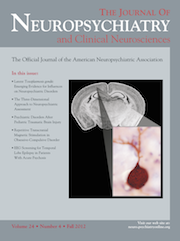The Role of Psychotic Disorders in Religious History Considered
Abstract
The authors have analyzed the religious figures Abraham, Moses, Jesus, and St. Paul from a behavioral, neurologic, and neuropsychiatric perspective to determine whether new insights can be achieved about the nature of their revelations. Analysis reveals that these individuals had experiences that resemble those now defined as psychotic symptoms, suggesting that their experiences may have been manifestations of primary or mood disorder-associated psychotic disorders. The rationale for this proposal is discussed in each case with a differential diagnosis. Limitations inherent to a retrospective diagnostic examination are assessed. Social models of psychopathology and group dynamics are proposed as explanations for how followers were attracted and new belief systems emerged and were perpetuated. The authors suggest a new DSM diagnostic subcategory as a way to distinguish this type of psychiatric presentation. These findings support the possibility that persons with primary and mood disorder-associated psychotic symptoms have had a monumental influence on the shaping of Western civilization. It is hoped that these findings will translate into increased compassion and understanding for persons living with mental illness.



